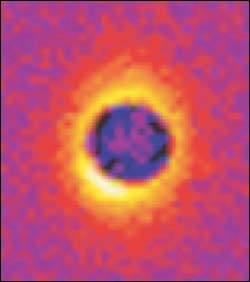Researchers help sort out the carbon nanotube problem

Small- angle neutron scattering pattern provides an inverted representation of how carbon nanotubes flowing in a polymer melt sort themselves by length. Longer nanotubes, which scatter neutrons at lower angles, gather in purple regions, while medium-sized and short nanotubes are indicated by red and yellow, respectively. The dark blue circle in the center of the image is the beam stop, which protects the sensitive detector from the transmitted beam of unscattered neutrons.
National Institute of Standards and Technology (NIST) and university researchers report a significant step toward sorting out the nanotube “problem”–the challenge of overcoming processing obstacles so that the remarkable properties of the tiny cylindrical structures can be exploited in new polymer composite materials of exceptional strength.
As described in the current issue of Physical Review Letters,* their analysis reveals that, during mixing, carbon nanotubes suspended in viscous fluids can be encouraged to sort themselves by length. Achieving uniform sizes of nanotubes is one of several keys to producing affordable, high-quality polymer nanocomposites.
The team found that, under common processing conditions, shorter carbon nanotubes will flow toward the walls of mixing equipment, while the longer tubes tend to congregate in the interior.
Better understanding of factors that promote this self-sorting will point the way to process adjustments and devices that achieve desired arrangements of nanotubes during bulk manufacturing of polymer nanocomposites, says NIST’s Erik Hobbie, leader of the collaboration, which included scientists from the University of Kentucky and Michigan Technical University.
Many times stronger than steel and possessing superlative thermal, optical and electronic properties, nanotubes have been called small-scale wonders, measuring a few nanometers in diameter and ranging greatly in length. Anticipated nanotube-based technologies range from hydrogen storage to transistors to space elevators. Nearest on the horizon are light-weight, high-strength carbon nanotube polymer structural composites.
With lasers, video microscopes and other optical monitoring equipment, the team tracked how nanotubes–both the single-wall and multiwall varieties–behave when suspended, at several different concentrations, in a polymer melt. They analyzed suspensions ranging in viscosity from syrup-like to watery under different mixing conditions.
The results did not suggest a “magic bullet” for getting nanotubes to align uniformly in the same direction–also critical to reliable processing of high-quality nanocomposites. But the finding that, under “modest flow conditions,” carbon nanotubes will sort by length could point the way to practical methods for bulk separation of nanotubes according to size.
Media Contact
All latest news from the category: Physics and Astronomy
This area deals with the fundamental laws and building blocks of nature and how they interact, the properties and the behavior of matter, and research into space and time and their structures.
innovations-report provides in-depth reports and articles on subjects such as astrophysics, laser technologies, nuclear, quantum, particle and solid-state physics, nanotechnologies, planetary research and findings (Mars, Venus) and developments related to the Hubble Telescope.
Newest articles

Webb captures top of iconic horsehead nebula in unprecedented detail
NASA’s James Webb Space Telescope has captured the sharpest infrared images to date of a zoomed-in portion of one of the most distinctive objects in our skies, the Horsehead Nebula….

Cost-effective, high-capacity, and cyclable lithium-ion battery cathodes
Charge-recharge cycling of lithium-superrich iron oxide, a cost-effective and high-capacity cathode for new-generation lithium-ion batteries, can be greatly improved by doping with readily available mineral elements. The energy capacity and…

Novel genetic plant regeneration approach
…without the application of phytohormones. Researchers develop a novel plant regeneration approach by modulating the expression of genes that control plant cell differentiation. For ages now, plants have been the…





















